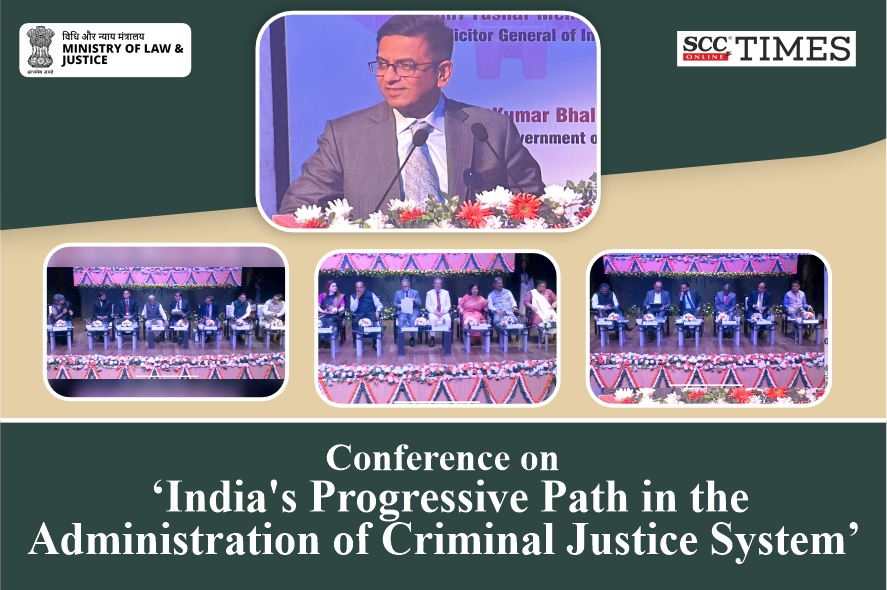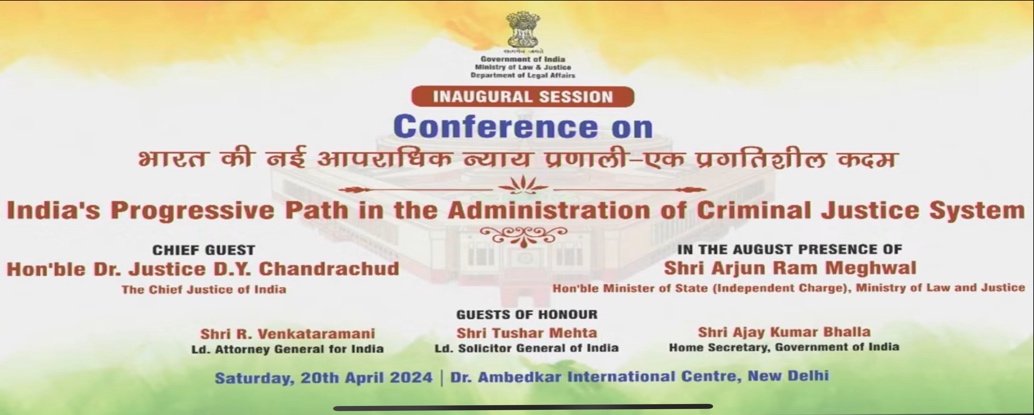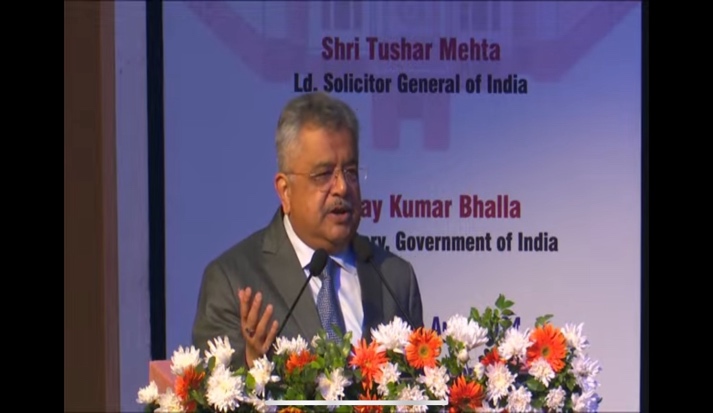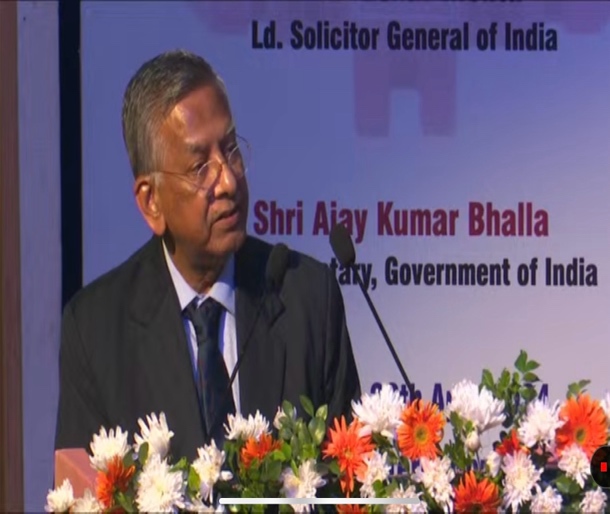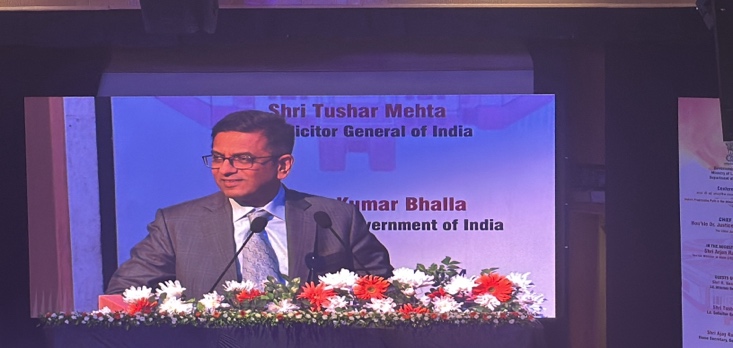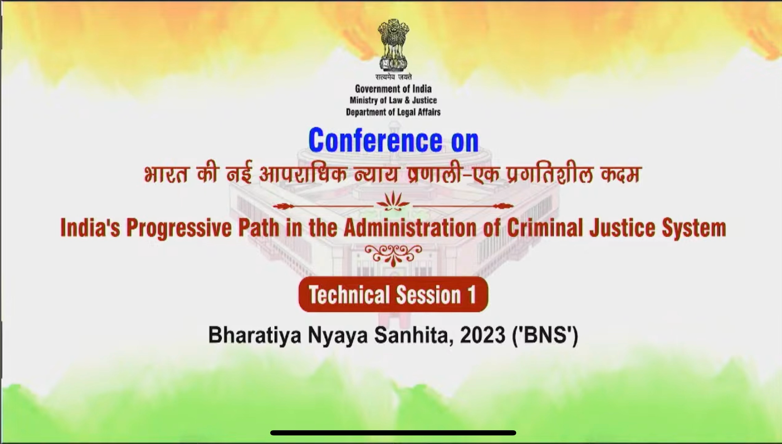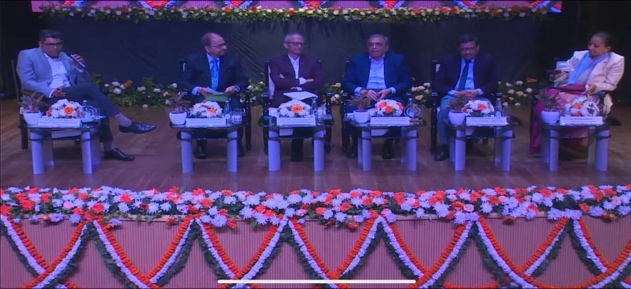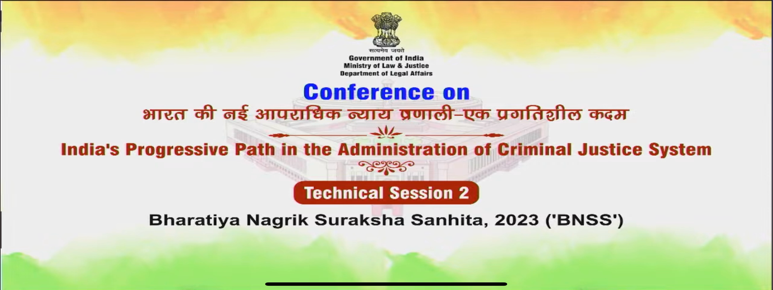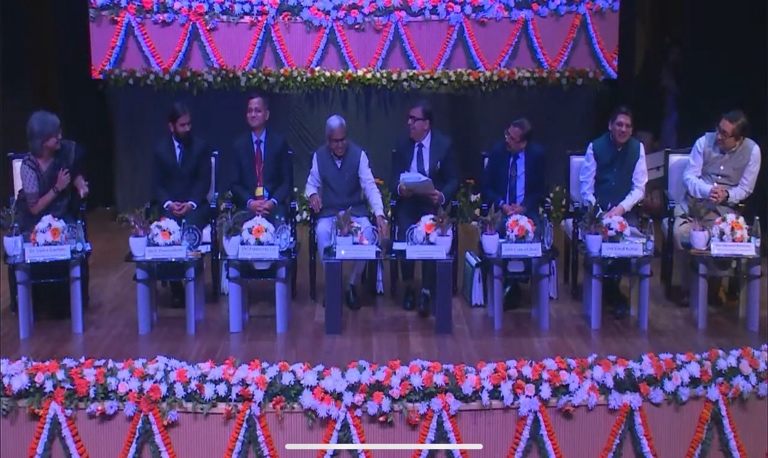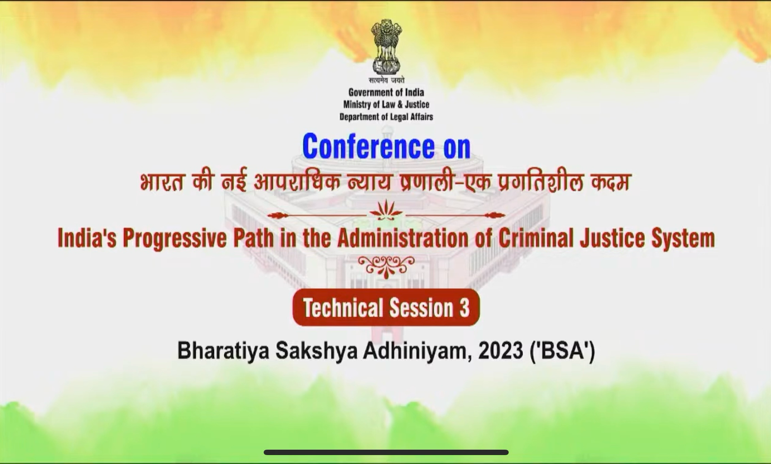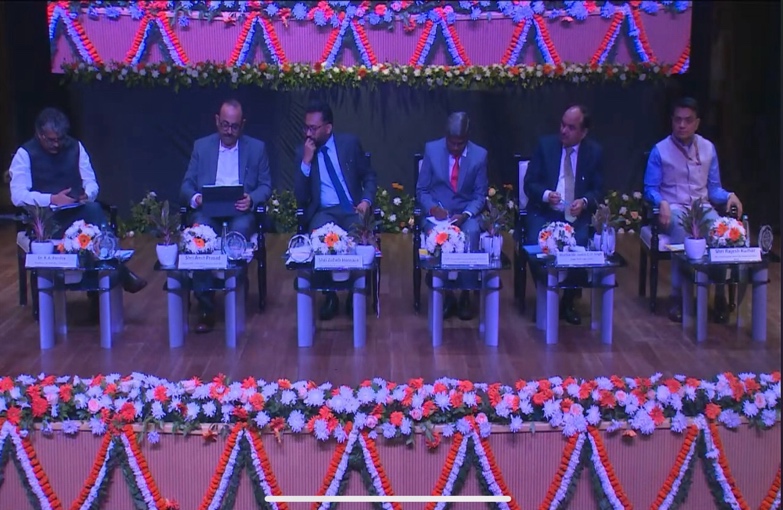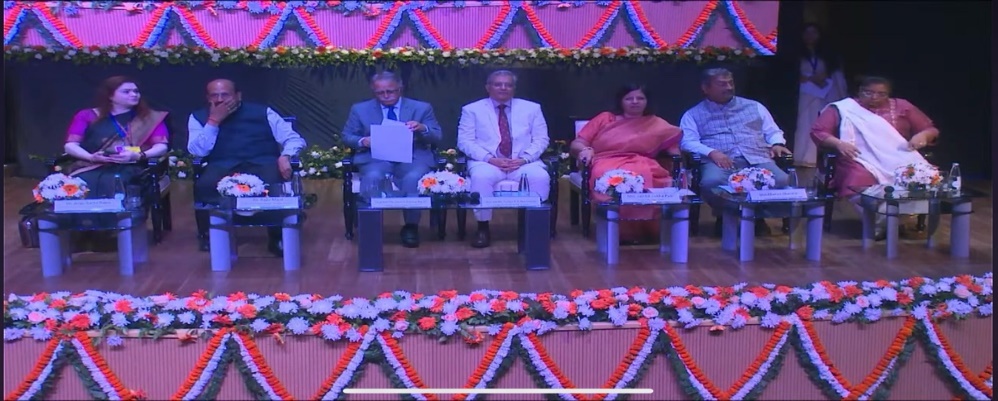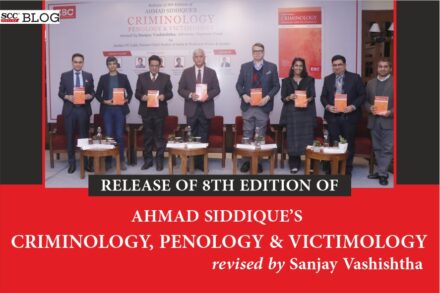The Ministry of Law and Justice organised a Conference on ‘India’s Progressive Path in the Administration of Criminal Justice System’, at Dr. Ambedkar International Centre, Janpath, New Delhi on 20-04-2024 for creating awareness on the three new criminal laws, namely the Bharatiya Nyaya Sanhita, 2023 (BNS); the Bharatiya Nagarik Suraksha Sanhita, 2023 (BNSS) and the Bharatiya Sakshya Adhiniyam, 2023 (BSA), repealing the Penal Code, 1860, the Code of Criminal Procedure, 1973 and the Evidence Act, 1872. The conference was graced by Dr. D.Y. Chandrachud, Chief Justice of India, as the Chief Guest.
Inaugural Session: Understanding the objective behind the Major Shift from Colonial-Era Laws
The tone for the conference was set by Dr. Anju Rathi Rana, Additional Secretary, Department of Legal Affairs, Ministry of Law & Justice, who introduced the theme of the conference. She welcomed the Chief Justice and all the dignitaries. 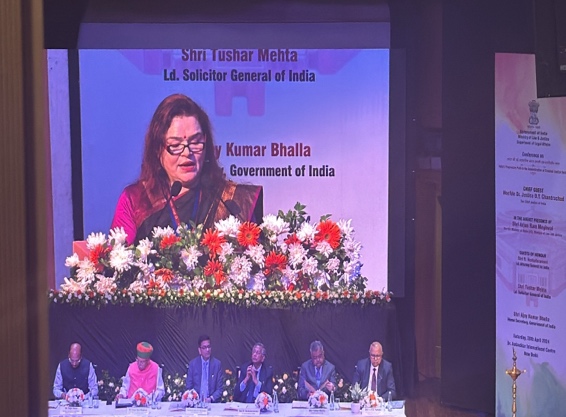
She said that this is a journey of enlightenment and exploration into the heart of one of India’s most crucial endeavours, the transformation of the criminal justice system. India’s legal landscape has transformative changes. She talked about the changing landscape of India and gave a brief introduction of all the three new Acts, repealing the old Acts. She said that these legislative milestones, repealing the colonial laws symbolise unerring commitment to adapt and evolve with ever-changing dynamics of our society and these reforms reflect India’s commitment to modernising its legal framework, enhancing efficiency, and ensuring justice to all.
Dr. Rajiv Mani, Secretary, Department of Legal Affairs, Ministry of Law & Justice in his address, after welcoming all the dignitaries said that this conference was a momentous opportunity. He discussed the Prime Minister’s speech which mentioned the ‘Paanch Pran of Amrit Kaal’, encompassing the removal of any trace of colonial mindset. 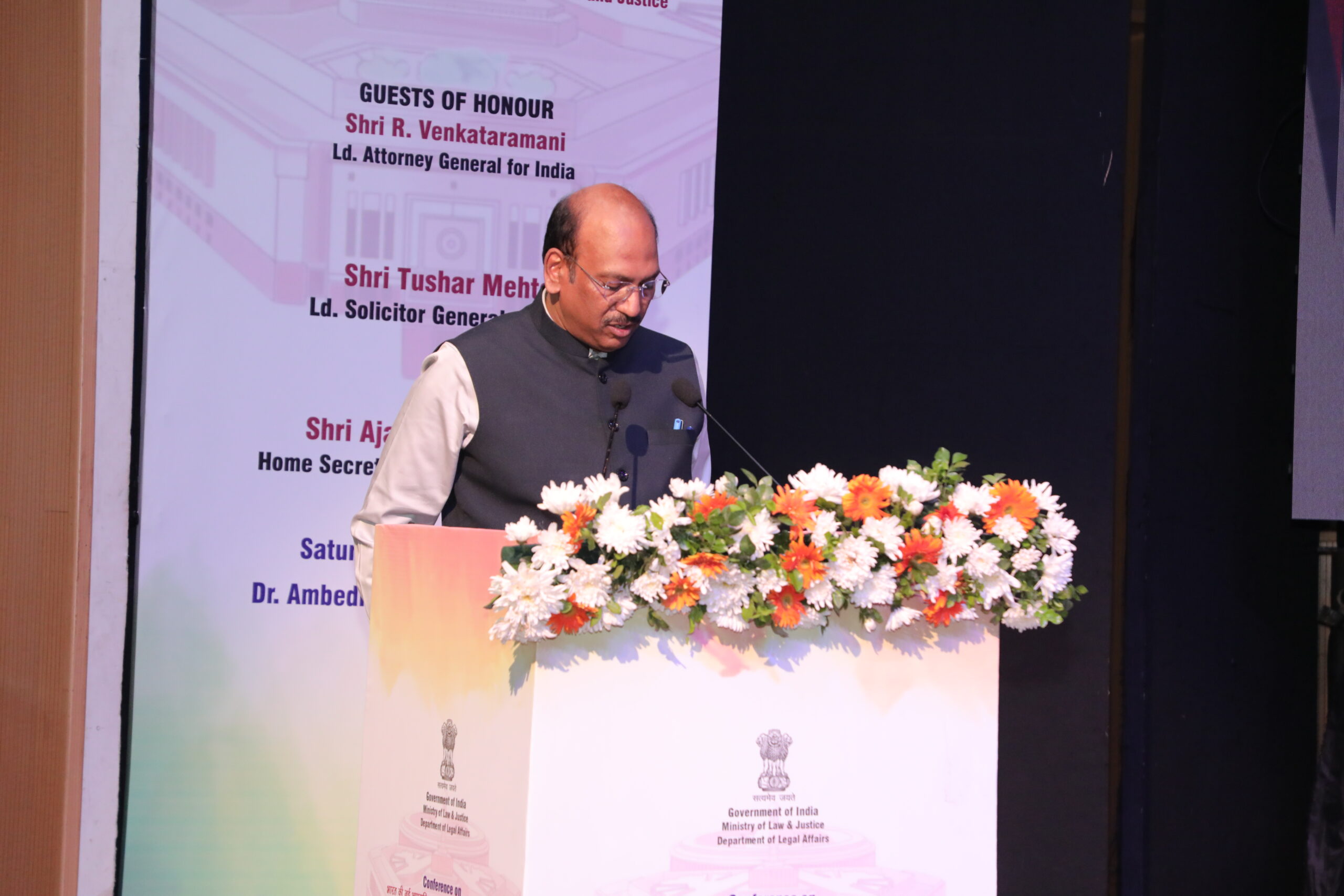
He highlighted the rich ancient system of law. He said that with the advent of Britishers, the codification of laws was done by Britishers for their own benefit. He stated that India has a rich heritage, to administer the country in the manner and principles which our ancestors gave us.
In the address by Mr. S.K.G. Rahate, Secretary, Department of Justice, Ministry of Law & Justice, he said that the long overdue overhaul of the criminal laws was successfully taken up. Highlighting the features of the three new criminal laws, he said that they incorporate several electronic features like issue of electronic summons, videography, lodging complaints through E-FIR etc. While highlighting the role of the Department of Justice, he said that the department has made strides, as to development of the justice delivery system. He enlightened the gathering with the implementation of the E-Courts project taken up for the computerisation of the District Courts. He also mentioned the pilot project taken up in one of the Districts of Madhya Pradesh for developing protocol of E- FIR, summons and bails.
Mr. Tushar Mehta, Solicitor General of India said that in the history of any nation, comes a time when you have to shift from old to new. He opened his address saying that before Independence, we were governed by the laws which were meant to rule us and not to give us the rule of law, we inherited that law and series of other laws in 1947, when the country was craving and demanding that now there would be a Indianised version. He said that the effective decision maker Prime Minister, Home Minister and above the will of the people has led to this change. While highlighting some of the important changes in the regime of the legislation and in the way, India thinks in the present era, he said that the judiciary, and even the lawyers are shifting to the digitisation and digital mode of dispensation of justice for the first time. Electronic mode is permissible in all criminal proceedings. He also discussed the problem of absconders, and that now Courts can pass conviction order against them. For the first time by a statutory mechanism, there is a provision of a mandatory requirement of zero FIR. He discussed an anti- criminal move and pointed that the first 15 days of investigation are crucial, and now that 15 days period is segregated, it can be used within 60 days or 90 days as the case maybe depending upon the nature of the allegation made against the accused, and it can be in instalments also.
He stated that continuing the status quo is an easy option, but changing the status quo requires courage and conviction.
Mr. R. Venkataramani, Attorney- General for India in his address said that the penal laws alone do not form the criminal justice system, but the investigator, the prosecutors, the Courts and the prisons, all exist in their interrelationship with each other. The perceptions and attitudes of the people in the community towards crime, are important elements in the administration of justice. The new Procedural Code (the BNSS) is not procedural, but protection based and talks about Suraksha. This is in tune with moving away from the Code, which was in exclusive domain of investigation, prosecution, etc. All procedure must avoid coercion, compulsion, discomfort and ensure self-protection. The use of word Suraksha is not only symbolic, but the provisions are slated towards fairness. The ‘nyaya’ signifies social justice.
Speaking on the occasion, Shri Arjun Ram Meghwal, Minister of Law and Justice pointed out the need for changes in the Criminal Justice system, which was initially brought into effect from the perspective of colonial rulers and lacked Indian spirit and ethos.
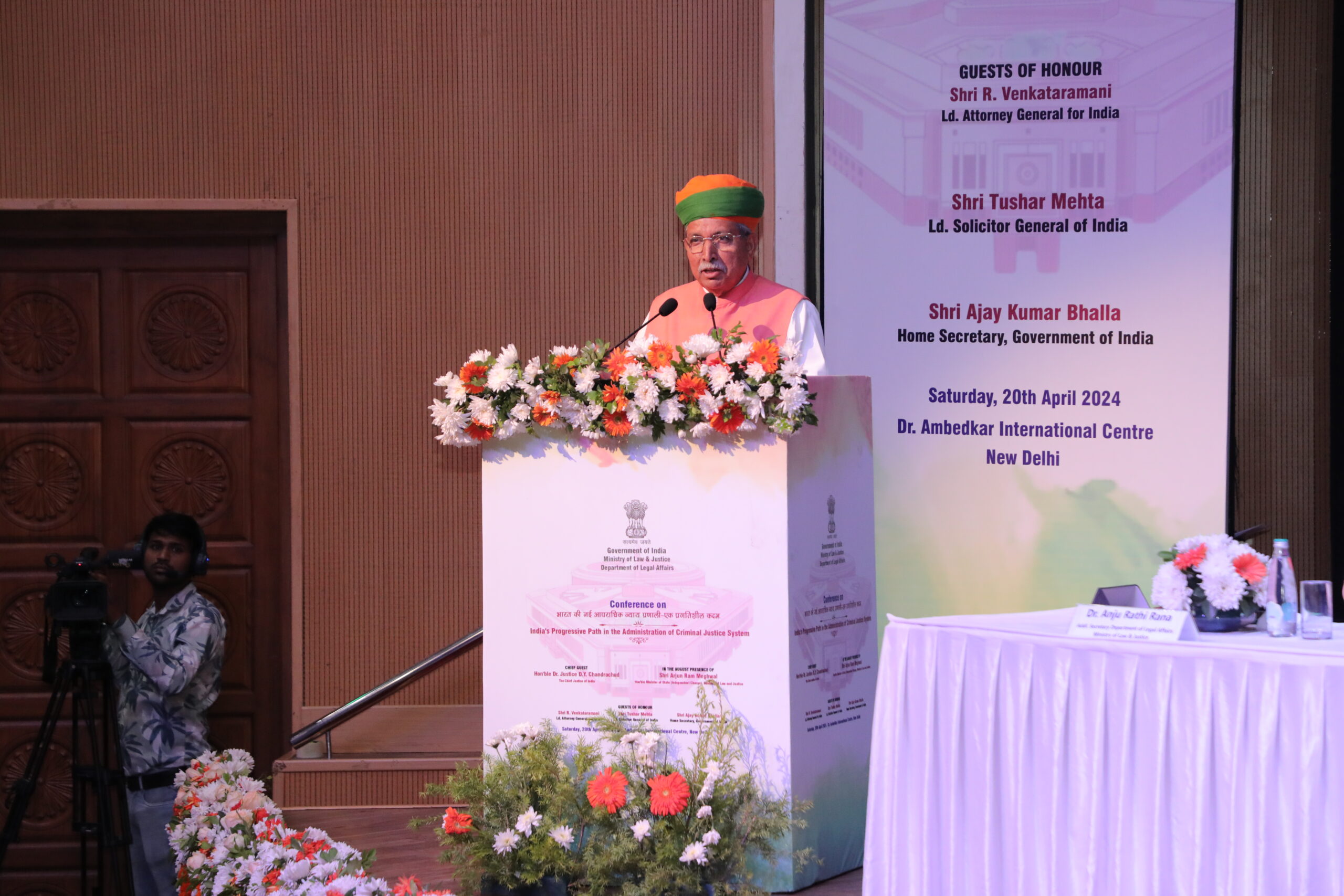
In the inaugural address delivered by Dr. DY Chandrachud, Chief Justice of India, he said that the new laws are watershed moment for our society because no law affects the day-to-day conduct of our society like criminal law. Criminal laws direct the moral arch of the nation and has the ability of depriving people of their cherished liberties as well. He also said that one of the problems of our criminal justice administration is that we treat the serious and the petty on the same footing, that has to change, and it has changed under the three new criminal laws. Further, he said that to bring positive changes, the infrastructure development, capacity building of forensic experts and investigating officers are to be made as soon as possible. India is on the move and that India needs new legal instruments.
He said that the laws needed to address concerns and operate issues like delays in the examination of witnesses, delays in the conclusion of trials, the overcrowding of prison and the issue of under trial prisoners. He also discussed the 248th report of the Standing Committee and noted that the Indian criminal justice system had struggles to keep up with these profound technological changes and social economic changes. He also highlighted that it is crucial to prioritize the privacy of both the victim and the accused.
TECHNICAL SESSION 1: BHARATIYA NYAYA SANHITA, 2023
Panelists
Chair: Mr. Justice Anoop Kumar Mendiratta, Judge, Delhi High Court.
Co-Chair: Mr. Mahesh Jethmalani, MP, Senior Advocate, Supreme Court of India
Ms. Aishwarya Bhati, Additional Solicitor General, Supreme Court of India; Mr. Praveen Kumar, Principal District & Sessions Judge, Delhi; Mr. Raja Thakare, Special Public Prosecutor & Advocate, Bombay High Court
Moderator: Dr. Neeraj Tiwari, Assistant Professor, National Law University, Delhi
In opening remarks by Mr. Mahesh Jethmalani, MP, Senior Advocate, Supreme Court of India, he highlighted his involvement in the most nascent stages of the conception of the three statutes, having been appointed as a member of the criminal law reform committees. While discussing the essence of all the three criminal laws, he said that the BNS has brought in significant changes in substantive criminal law, while retaining a substantial part of the Penal Code, 1860. The BNSS, introduces on the other hand, sweeping changes in the procedure designed to galvanise India’s justice system through the imposition of strict timelines for various stages and aspects of investigations, enquiries, trials, judgments, and appeals as also by the introduction of liberal use of the electronic medium to enhance its efficacy. It is victim friendly and gives opportunities to accused of fair representation. There have been minimal changes in the BSA.
On the question of transition from ‘Dand’ to ‘Nyaya’, posed by Dr. Neeraj Tiwari, he said that it does not entail sweeping changes in law from the former Code, that was predominantly concerned with deterrence of crime. The present Sanhita restrains this deterrence aspect but introduces provisions which focus on providing justice to all stakeholders.
Ms. Aishwarya Bhati, Additional Solicitor General, Supreme Court of India, discussed the chapterisation of the BNS. She also pondered over the question that why Law has to be such a difficult formula, that it is not easily understood by anyone and takes a lot of effort, regular training to get a grasp of the law by practitioners of law, people involved in the justice delivery system, dispensation of law, investigators, reading training.
She highlighted that the problem of complicated and scattered chapters under the IPC has been resolved and discussed how the Chapter 5 of the BNS consolidates the offences related to women and children at one place, which were previously scattered under 4 separate chapters of the IPC. She said that arrangement of offences is in the manner, which is easily understood to the layman. The common man’s perspective that he had to go through IPC and what the Supreme Court has held, has been taken care of and the definitions for various offences has been included in a simplified language. All the major reforms, significant judgments in the past 75 years have been included in the BNS.
On sexual intercourse by false promise of marriage, she said that it was already criminalised as a part of rape but the significant step under the BNS that it has been segregated and kept out of rape. The ‘deceit’ in the promise has been the focal point and the false promise to marry cannot be equated with other cases of rape.
On the question posed by Dr. Neeraj highlighting the reformative approach of the IPC, as to inclusion of the ‘community service’ as punishment, Justice Anoop Kumar Mendiratta, Judge, Delhi High Court took Ms. Aishwarya’s thought further and agreed that the change is not about mere changing the scheme of the Act but to include the perspective of a common citizen. The community service, which has been introduced as a significant move from the benefit of the citizen. While discussing the scheme of punishment, he said that earlier the shift was from deterrent to retributive, but now the change is from retributive to reformative. He said that there has been a balance between the punishments as there is enhancement of the sentences and posing of minimum statutory sentencing pattern. He said that the BNS somewhere adopts the earlier pattern, but definitely so far as community service is concerned, it has been introduced for the first time and what are the parameters, nature of service to be performed has been left to the discretion of the court. While discussing the implementation of this newly introduced punishment, he highlighted the six offences, for which the community service has been prescribed.
Justice Praveen Kumar, Principal District & Sessions Judge, Delhi, on the question that how he perceives the enhancement fines and imprisonment alongside the introduction of community service, opined that the enhancement of punishments, alone, will not discourage people from committing crime. To substantive his opinion he cited the Nirbhaya case, wherein, the convicts were given stringent punishments and still the rape cases are on their rise.
Quoting from Mahabharata- “I know what Dharma is, but I cannot walk on that path”, he said that the socio-economic condition and psychology of a person influences their criminal behaviour. He said that if the investigation is fair, chargesheets are filed without delay, and if the trials are concluded expeditiously, that will act as a deterrent. He said that time is the test for these increased punishments, as to how effectively they will reduce the crime. He concluded that deterrence, alone, is not sufficient.
Mr. Raja Thakare, Special Public Prosecutor & Advocate, Bombay High Court, on the question that how he sees the BNS, striking a balance between over- criminalisation and de-criminalisation, stated that “criminality is like gunpowder lying harmless in the gun, unless it is ignited by some external act” and there are various factors which constitute the offence. He highlighted the moral grounds, anger, jealousy, economic condition, hunger, etc. as these external factors, leading to crimes. He said there were some general offences, such as offences against the human body and the State, which were drafted in the IPC, way back in 1860, still find their way in the BNS. He discussed some important deletions, such as the Section 377 of the IPC, Section 124-A, Section 309, etc. In respect of over- criminalisation, he said that the hit and run matters, has been recognised and it is a laudable move that the same has been put under Section 106 of the BNS and the punishment is enhanced to 10 years.
TECHNICAL SESSION 2: BHARATIYA NAGARIK SURAKSHA SANHITA, 2023
Panelists
Chair: Justice Ashwani Kumar Mishra, Judge Allahabad High Court
Co-Chair: Justice K.T. Shankaran (Retd.), Member, Law Commission of India
Mr. Vikramjit Banerjee, Additional Solicitor General, Supreme Court of India
Mr. Vinod Kumar, Principal District and Sessions Judge, Delhi
Mr. D.C. Jain, IPS (Retd.), Former Special Director, Central Bureau of Investigation
Mr. Praveen Kumar, IPS, Additional Director, Intelligence Bureau, Government of India
E. Chandrasekaran, Advocate, Madras High Court
Moderator – Dr. Upma Gautam, Associate Professor, GGSIPU, Delhi
Justice Ashwani Kumar Mishra, said that first and foremost, it is essential to acknowledge the definition clause as the initial provision, which sets the tone for the entire legislation. Notably, this legislation marks the first time that audio, video, and electronic means have been comprehensively defined. Additionally, the definition of electronic communication has been established. Our civilization, with its deep-rooted quest for justice, particularly emphasizes the need for reform. Over the years, there has been a growing sentiment that the criminal justice system is failing to meet the expectations of a just society.
Since the inception of the Indian Constitution, which pledged justice – social, political, and economic- for all, we’ve seen continuous efforts, spanning 75 years, through various legislations and amendments to address these issues. Now, the Parliament recognizes the necessity for Indianizing the criminal justice system while preserving its fundamental provisions that serve the cause of justice.
Many provisions have been retained due to their alignment with our constitutional framework and their efficacy in serving the larger objective of justice. However, there is a recognition that certain areas require attention and reform. He quoted Justice Krishna Iyer, “procedure is the handmaid of justice,” and said that when procedural complexities impede the delivery of justice, amendments become imperative. One critical area addressed in the legislation is the definition of electronic communication. Drawing from personal experiences at the bar and bench, it’s evident that inefficiencies exist, particularly during the initial stages of lodging an FIR and conducting investigations. The introduction of provisions like ‘zero FIR’ aims to mitigate delays, while leveraging technology, such as audio, video, and electronic means, for evidence collection can significantly expedite the process. Moreover, there’s a need to streamline the investigation process, enforce provisions effectively, and ensure the protection of victims’ interests. Simply enacting the laws is insufficient; meticulous attention to implementation and public awareness is crucial to realizing the intended benefits of these legislative changes.
Justice K.T. Shankaran (Retd.), said that the amendment regarding police custody (Section 167 (2) CrPC = Section 187 of the BNSS) is a commendable change, particularly in curbing the misuse of claiming illness by influential individuals upon arrest, thereby evading police questioning. However, concerns are raised regarding Section 223 of the BNSS Act, specifically its impact on the magistracy’s authority and fairness in proceedings. Amendments to rectify these flaws are warranted.
Mr. Vikramjit Banerjee, in response to question on the accountability aspect of the prosecution reforms, key provisions empowering the Director of Public Prosecutions (DPP) to oversee appeals and ensure timely resolution of cases are highlighted. These interventions aim to prevent frivolous appeals and enhance the efficiency and supervision of the judicial process, emphasizing that the objective is not merely pro-conviction but ensuring a balanced and just outcome.
Mr. Vinod Kumar on the question about the potential improvement in the perception of the criminal justice machinery among stakeholders due to the legislative changes, said that it is affirmed that the new legislation has injected a renewed enthusiasm among legal practitioners, judiciary, prosecutors, and law enforcement personnel. The provisions offer protection to all involved in the criminal justice system and are perceived as a positive step towards enhancing trust and efficiency.
Mr. D.C. Jain emphasized the issue of pending investigations and trials and said that the focus is on addressing the problem of false litigation, which burdens the system. The amendments aim to strike a balance in tackling false complaints while ensuring fundamental issues like prosecution sanction are addressed effectively, thus contributing to the improvement of the criminal justice system.
Regarding the infrastructure support required for implementing the legislative changes, Mr. Praveen Kumar, IPS, said that initiatives such as the E-Sankalan app and bolstering forensic capabilities taken up. He emphasized on leveraging technology and enhancing training to strengthen the pillars of implementation, namely investigation and forensics.
Mr. E. Chandrasekaran, on how the BNSS supports victims, said that it is underscored that the legislation is inherently victim-centric, seeking to achieve a balance between victims’ rights and those of the accused. Provisions such as plea bargaining and protections against false imprisonment aims to ensure fairness and justice for all parties involved. In conclusion, the legislative amendments represent a significant step towards reforming the criminal justice system, addressing longstanding issues, and fostering trust and efficiency among stakeholders. However, careful implementation and ongoing evaluation are vital to realizing the full potential of these reforms.
TECHNICAL SESSION 3: BHARATIYA SAKSHYA ADHINIYAM, 2023
Panelists
Chair: Mr. Justice C. D. Singh, Judge, Delhi High Court
Co-Chair: Mr. M. Karunanithi, Advocate, Member (Part-time), Law Commission of India
Ms. Seema Maini, Principal District & Sessions Judge, Delhi
Mr. Rajesh Kumar, IPS, Chief Executive Officer, I4C, Ministry of Home Affairs
Mr. Zoheb Hossain, Special Public Prosecutor, Enforcement Directorate
Mr. Amit Prasad, Special Public Prosecutor & Advocate, Delhi High Court
Moderator: Dr. K.A. Pandey, Professor, RMLNLU, Lucknow
Dr. K.A. PANDEY posed a question to Mr. Rajesh Kumar, IPS, on the three law that are going to unfold from 01-07-2024. Would you agree that the evolution of law of evidence in India has been smoother than the other two laws?
Mr. Rajesh Kumar, IPS, while agreeing on the smoother evolution of law of evidence as compared with the evolution of the other two laws. He said that the law of evidence remained intact since 1872. Some parts were amended in 2000 and 2008 due to change in Information Technology Act, 2000. He said that the BSA has undergone very minimal changes as compared to the BNS and BNSS. The law of evidence needs to be more Indianised, and it must be able to be adopted in changing circumstance and adopt technological changes. As many investigating officers who are looking at a criminal case, would agree upon that most of the evidence are found in the digital realm today.
While answering the three most notable features of the BSA, which the Evidence Act lacked, Mr. Amit Prasad, said that the BSA essentially covers up all the missing points related to rules of electronic evidence while expanding the territorial extent of applicability and introducing the rules related to protection for citizen. The BSA now explains what electronic evidence is, while covering different types of electronic evidence (documents and recordings) and recognizes how these e-evidence are recorded in this new age (network device, cloud storage, semi-conductors, memories) all the possible new ways of recording evidence and their technologies. He also said that the courts, up till now, covered these gaps by laying down the guidelines and trying to identify these aspects, and now most of these have been incorporated in the new act to fill the gaps. While discussing the expansion of applicability, he said that ‘if merely somebody gets the documents it doesn’t become evidence’. It needs to be tendered by someone from overseas or solely, one can’t tender it. The BSA has given us the opportunity to record evidence through digital mode. Lastly talking about the feature of public friendliness, the BSA states that ‘the accomplice statement can become ground for conviction if it is corroborated’, features like this makes the BSA more public friendly and protect citizen’s interests.
He emphasized that even if somebody has got the data, it will not become evidence on its own. It must be converted as evidence to be read as evidence, though it can be converted into evidence after tendering it into a Court of Law. The person who is tendering the date will be the subject of cross examination also. According to Evidence Act will tender the evidence by the person who presented the data was necessary through the process of presenting its relevance via 65B. The hefty process of tendering the data into evidence has been take care of under the BSA.
Dr. K.A. Pandey- Section 24 of BSA, that corresponds to Section 30 of the Evidence Act adds an explanation that the trial of a person in absentia along with other person will be a joint trial. So, will it be a joint trial if both the co-accused person tried in absentia, or one must try in person to make Section 24 applicable. Mr. Zoheb Hossain, Special Public Prosecutor, Enforcement Directorate, said that Explanation 2 of the Section 24 made the provision an enabling section. And, if the accused is absconding a trial can proceed in absentia. Whereas, in Section 23 of BSA if one of the co-accusers gave their confession in enquiry phase in front of the Magistrate, then one can proceed with trial of absentia, if no co-accuser is present. He emphasized that it does require some judicial interpretation. He also said that there are foreseeable challenges for the lower judiciary, which will require sufficient standard operating procedures, training to be able to accept and present primary evidence, which will be the proper practice to present it.
The definition of documents under Section 2(1)(d) of the BSA specifically includes electronic and digital records. Additionally, the definition of evidence 2(1)(e) of Bharatiya Nyaya Sanhita, it includes statement given electronically. While answering the practical implication, Rajesh Kumar, IPS, said that these are two gamechanger amendments that have been brought. The words inserted through changes were- ‘electronically recorded’ and ‘documents’. Today, in every criminal trial, there is at least one evidence, which is stored electronically, and this provision will help to shorten the time of process of sending notices and collecting evidence.
While answering a question related to limited scope of its to rape under Section 64(2) of BNS M. Karunanithi said that it is a cautious omission. According to the Section 120 of BSA ‘consent of women either can be obvious or can be inferred by the evidence’ limits its punishments to aggravated forms of rape under Section 64(2) of BNS. Justice C.D. Singh expressed his gratitude towards the Ministry of Law and Justice for organizing the conference. He said that these three laws have been enacted after 175 years, and that it was much needed due to staggering procedure use by previous Acts. Introducing the provisions related to documents, evidence, electronic records, tendering of evidence, and citizen friendliness are the most important changers. The main concern is that the law on evidence is also applicable in the civil matters and now this poses a question that whether the changes in the CPC are required or not. Some other concerns include the artificial intelligence and data protection in relation to the collecting the electronic evidence, store the evidence data and maintaining of the records. He highlighted that experts are required in the field to tackle with these concerns and manage the frauds.
VALEDICTORY SESSION: IMPACT AND WAY AHEAD OF CRIMINAL LAW TRIAD
Dr. Rajiv Mani, Secretary, Department of Legal Affairs, Ministry of Law & Justice, welcomed all the dignitaries at the final session and opened the valedictory session. He concluded the highlights of the conference. On behalf of the Department of legal affairs, Ministry of Law and Justice, he thanked all the audience and the panellist who have contributed in this important discourse, especially on raising very pertinent issues which are going to have some implications on the implementation of these laws.
Mr. Chetan Sharma, Additional Solicitor General, Delhi High Court, called the conference- ‘a watershed moment’ because this is the first time that the three new criminal laws were discussed to this extent. He complimented the Law Ministry on hosting such large-scale conference. He also discussed the key highlights of all the three laws.
Ms. Chhaya Sharma, Special Commissioner, Training, thanked all the participants and dignitaries. She discussed the key changes in the three criminal laws, as to how they have become victim and women friendly. She also highlighted the training programmes undertaken by the Police, and around 10,000 investigating officers have been trained under this programme. She also said that the soul of the three new laws will be to protect all the rights given to the Indian citizens by the Constitution and their purpose will not to punish, but to give justice.
Justice Rekha Palli, Judge, Delhi High Court said that the conference aimed to raise awareness among stakeholders about the crucial reforms about to be ushered in. She emphasized that ‘the criminal laws of a nation reflect the values and beliefs of its citizens, thereby depicting the collective cognitive consciousness and embodying the moral compass of the nation.’ She continued, stating that ‘this branch of law has to evolve along with societal changes; criminal law cannot and should not remain static.’ She quoted Roscoe Pound, an American legal scholar, who once said, ‘law must be stable but must not be static.’
‘All the three laws that formed the bedrock of criminal jurisprudence in our country were, however, entrenched with colonial legacy, both in language and substance,’ Justice Palli elaborated. Over the years, as the world’s largest democracy, we have moved from a society that functioned on the basis of retaliatory justice to one based on reformatory justice, which acknowledges that an accused is capable of being reformed. A system where victims are not merely bystanders.
She emphasised that amendments were coming, but there was no clarity. It was the need of the hour for a complete overhaul. The enactment of these Acts sends a loud message to the world that we will only abide by laws which meet the aspirations of our citizens and not by earlier laws. These acts logically reorganize the provisions into a more user-friendly legal framework. For instance, in order to bring clarity, definitions under the Acts have been arranged alphabetically, which was not the case earlier. Redundant provisions have been deleted. This change reflects a fundamental understanding that individuals are more likely to adhere to the law in the language and form they can easily understand.
She also emphasised the role of AI and said that as we stand at the threshold of another technological revolution, the artificial intelligence is likely to become a part of our daily life in the very near future, our laws could not have ignored this advancement. These Acts will definitely streamline the justice delivery system, enhance its efficiency, ensure transparency, and instil greater public confidence in the criminal justice system. She also said that introduction of “Community Service” as a form of punishment will be an effective alternative to incarceration and will also help in tackling the problem of overcrowding in prisons.
Justice Sanjay Karol, Judge, Supreme Court noted that the nomenclature of judicial officers has changed, bridging the gap between metro-centric approach and other rural areas. This is the mandate of the constitution — the concept of speedy trial. Infrastructure has to be implemented at the ground level to ensure justice to all. Delay is the most potent roadblock in the realization of this right. The new statutes would bring in an era whereby at least the poor man will be rendered justice.
Justice P.S. Narasimha, Judge, Supreme Court remarked, these three new Acts are going to directly affect citizens’ lives. He said that we are now shifting from what was given to us to what we want it to be, which is a significant transition.
‘Courts have done this act of decolonisation through the process of interpretation,’ he added. Large scale legislative reforms can take shape in many ways, including the repeal of laws that are no longer necessary, the creation of new laws to regulate areas that were either outside the law or were not adequately regulated, and the consolidation of laws into one simple theme. The Nyaya Sanhita which replaces IPC, the Nagarik Sanhita which replaces the CrPC, and Sakshya Adhiniyam which replaces the Evidence Act, have endeavoured to reform a large body of criminal laws in the country by substituting old laws with new ones, Justice Narasimha, concluded. A continuous engagement with existing laws is an absolute must to prevent stagnation or outdated laws. Such reforms provide an opportunity to undertake a systemic review of law.
In the closing speech by Dr. Anju Rathi Rana, Additional Secretary, Department of Legal Affairs, she concluded the speech by extending a final gratitude to all attendees, while also acknowledging the support and assistance of EBC and others in organizing the conference.


